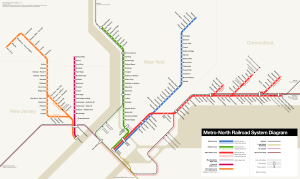
Back Metro-North Railroad German Ferrocarril Metro–North Spanish Metro-North Railroad Estonian مترو-راهآهن شمال Persian Metro-North Railroad French Metro-North Railroad ID Metro-North Railroad Italian メトロノース鉄道 Japanese 메트로 노스 철도 Korean Metro-North Railroad Dutch
| Metro-North Railroad | |||
|---|---|---|---|
 Metro-North Railroad provides services in the lower Hudson Valley and Western Connecticut. | |||
| Overview | |||
| Owner | Metropolitan Transportation Authority | ||
| Locale | Hudson Valley of New York; Southwestern Connecticut[1] | ||
| Transit type | Commuter rail | ||
| Number of lines | 5 rail lines[1] | ||
| Number of stations | 124[1] | ||
| Daily ridership | 233,600 (weekdays, Q4 2023)[2] | ||
| Annual ridership | 60,569,700 (2023)[3] | ||
| Chief executive | Catherine Rinaldi[4][5] | ||
| Headquarters | Graybar Building New York, New York[6] | ||
| Website | new | ||
| Operation | |||
| Began operation | 1983[7] | ||
| Operator(s) | Metropolitan Transportation Authority NJ Transit (west-of-Hudson) | ||
| Reporting marks | MNCW | ||
| Character | At-grade, elevated, and underground | ||
| Technical | |||
| System length | 787 mi (1,267 km)[1] (385 mi (620 km), routes) | ||
| Track gauge | 4 ft 8+1⁄2 in (1,435 mm) standard gauge | ||
| Electrification | Third rail, 750 V DC Overhead line, 12.5 kV 60 Hz AC | ||
| |||
Metro-North Railroad (reporting mark MNCW),[8] trading as MTA Metro-North Railroad, is a suburban commuter rail service operated by the Metropolitan Transportation Authority (MTA), a public authority of the U.S. state of New York. Metro-North serves the New York Metropolitan Area, running service between New York City and its northern suburbs in New York and Connecticut, including Port Jervis, Spring Valley, Poughkeepsie, Yonkers, New Rochelle, Mount Vernon, White Plains, Southeast and Wassaic in New York and Stamford, New Canaan, Danbury, Bridgeport, Waterbury, and New Haven in Connecticut. Service in Connecticut is operated under contract with the Connecticut Department of Transportation. Metro-North also provides local rail service within the New York City boroughs of Manhattan and the Bronx.
Metro-North is the descendant of commuter rail services dating back as early as 1832. By 1969, they had all been acquired by Penn Central. MTA acquired all three lines by 1972, but Penn Central continued to operate them under contract. Service was transferred to Conrail in 1976, when it absorbed most of Penn Central's railroad functions after Penn Central's bankruptcy. The system took its current form in 1983, when the MTA took over direct operation of Conrail's commuter services in the northern portion of the Tri-State Area and formed Metro-North to run them.
There are 124 stations[7] on Metro-North Railroad's five active lines, which operate on more than 787 miles (1,267 km) of track,[1] with the passenger railroad system totaling 385 miles (620 km) of route.[9] It is the second busiest commuter railroad in North America in terms of annual ridership, behind the Long Island Rail Road and ahead of NJ Transit (both of which also serve New York City).[1] As of 2018[update], Metro-North's budgetary burden for expenditures was $1.3 billion, which it supports through the collection of taxes and fees.[10] In 2023, the system had a ridership of 60,569,700, or about 233,600 per weekday as of the fourth quarter of 2023.
The MTA has jurisdiction, through Metro-North, over railroad lines on the western and eastern portions of the Hudson River in New York. Service on the western side of the Hudson is operated by NJ Transit under contract with the MTA. Additionally, connecting ferry service is operated by NY Waterway, also under contract with the MTA.[11][12]
- ^ a b c d e f "The MTA Network". MTA. Retrieved April 24, 2018.
- ^ "Transit Ridership Report Fourth Quarter 2023" (PDF). American Public Transportation Association. March 4, 2024. Retrieved March 14, 2024.
- ^ "Transit Ridership Report Fourth Quarter 2023" (PDF). American Public Transportation Association. March 4, 2024. Retrieved March 14, 2024.
- ^ "Catherine Rinaldi Named as President of Metro-North Railroad". MTA (Press release). February 21, 2018. Retrieved April 24, 2018.
- ^ "Catherine Rinaldi". MTA. Retrieved February 8, 2022.
- ^ "Contact Us". MTA. Retrieved April 24, 2018.
- ^ a b "About MNR". web.mta.info. Retrieved January 17, 2016.
- ^ "AAR Railroad Reporting Marks (2021)". www.railserve.com. Retrieved January 15, 2023.
- ^ "Comprehensive Annual Financial Report for the Years Ended December 31, 2012 and 2011" (PDF). Metropolitan Transportation Authority (MTA). June 21, 2013. p. 147. Retrieved August 29, 2014.
- ^ Rivoli, Dan (February 13, 2018). "MTA Budget: Where does the money go?". NY Daily News. Archived from the original on November 3, 2018. Retrieved November 3, 2018.
- ^ "Haverstraw-Ossining Ferry and Metro‑North Railroad". MTA. Retrieved December 28, 2023.
- ^ "Metro-North Railroad announces resumption of ferry service". Mass Transit. July 20, 2021. Retrieved December 28, 2023.
© MMXXIII Rich X Search. We shall prevail. All rights reserved. Rich X Search
